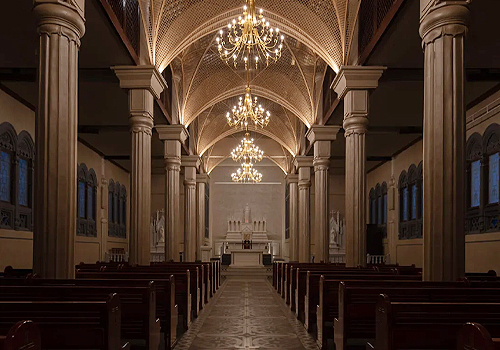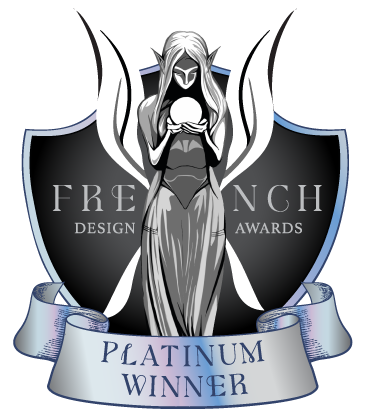
Interview
Bin Fan & Xiaoying Zhang

1 Please give us a brief bio of yourself and your design background.
We are Bin Fan & Xiaoying Zhang, lead designers for the project by Chengdu DOV Design Co. We have over 30 years of design experience, and currently, we're focused on international business development.
2 What made you become/why did you choose to become a designer/artist?
In the context of the times, designers were respected and had social responsibilities and a sense of duty while also contributing to the development of the environment, which is why we chose the profession of a designer.
3 Tell us more about your agency/company, job profile, and what you do.
Multidimensional Design Company was established 30 years ago, headquartered in Chengdu, Sichuan, China. It primarily engages in commercial and public interior design, small-scale architectural design, and furniture design, with business operations in the Americas, Australia, and Africa.
4 What does “design” mean to you?
For us, design is a form of applied art, a fusion of technology and philosophy, which plays a significant role in the development of human society as a whole. It is the forerunner of technology.
5 What’s your favorite kind of design and why?
We believe the categorisation of design is not important; the key is the design methods and ideas. We prefer designs that are valuable to society, contribute to the quality of life for humanity, and promote sustainable development of the environment.
6 To you, what makes a “good” design?
A good design is design that is valuable to society, contribute to the quality of life for humanity, and promote sustainable development of the environment.
7 How did you come up with the idea for your award-winning design?
The project involved the reconstruction of YaYa Pond, with the core project being the renovation and update of the interior of the Catholic Church. We had two responsibilities: first, to maintain and protect the cultural heritage of the church, which is the core building of the block; second, to revitalise the community and commercial atmosphere around the church, thereby bringing new vitality to people and society. We aimed to ensure that the entire space would have a long-lasting life.
8 What was your main source of inspiration for this design?
The Catholic Church was originally built by a French missionary in 1802 and officially rebuilt in 1898. The earliest ceiling featured a bamboo lattice from the local culture. Taking into account the local culture and religious practices, the texture of "Daoming Bamboo Weaving" was extracted and applied to the Gothic vaulted decorations. Considering public building fire safety, stainless steel material was used to imitate bamboo weaving, which gives the design both a contemporary feature and a historical quality.
9 Do you think your country and its cultural heritage has an impact on your design process?
The building itself is a cultural heritage. The French missionary designer of the time adopted a Sino-European hybrid style, focusing primarily on participation and respect. During this design process, we immersed ourselves in reverse studying and understanding the design concept of the architectural complex, as if spending months with the French missionary designer from a century ago, eventually continuing to respect and develop the local cultural heritage.
10 Congratulations! As the winner of the French Design Awards, what does it mean to you and your company and team to receive this award distinction?
Thank you! Our company has won multiple international awards, but this is the first time winning the French Design Awards, which helps us to go global and align with the trend of globalisation.
11 Can you explain a bit about the winning work you entered into the French Design Awards, and why you chose to enter this project?
The Catholic Church has been in existence for over 200 years and is one of the few buildings of its kind in China and the world, akin to the Notre Dame Cathedral in Paris. Due to various historical reasons, it has been damaged multiple times and has undergone several changes. This project is a process of rebuilding and growth. We chose to participate in this project because it was built by a French missionary and is a historical renovation that represents the fusion of Chinese, French, and local cultures. While paying tribute to the French missionary architect, we hope to use contemporary technology to bring back the fragments buried in the river of history a century ago.
12 What were the main challenges you faced during the design process, and how did you overcome them?
The Catholic Church is a Sino-Western hybrid architecture with significant historical weight, which placed great pressure on the designer. The designer needed to respect history while also creating new value. We held reservations about the "repair the old as the old" approach and prefer to practice the "authenticity" principles of the Venice Charter, which include the following views: 1. The new must respect the old. 2. The new should compensate for the regrets and shortcomings of the old. 3. The new derivative part must have the evolution and footprint of the old. 4. Ensure a perceptual difference between the new and the old. 5. The new should feel "old" in spirit and atmosphere. The handling of the church's surrounding courtyards also applied these views, forming an overall concept.
13 How do you think winning this award will impact your future as a designer?
We have seen the ideas of cultural diversity, cultural integration, and sustainable development. The collision of different traditional cultures can coexist harmoniously with the help of today's technology.
14 What are your top three (3) favorite things about the design industry?
1. International exchange 2. Bringing value to clients through projects 3. Making meaningful contributions to the sustainable development of the human environment
15 What sets your design apart from others in the same category?
This is the restoration and renovation of an old building, not a new construction. The design approach involves finding ideas under existing conditions. How to reasonably "stand on the shoulders of giants" is the question. The design is like a dancer carefully performing in a china shop, displaying a beautiful dance, interacting with the audience, while also preserving the beauty of the china shop.
16 Where do you see the evolution of design industry going over the next 5-10 years?
With the development of AI, the value of design will gradually shift towards creativity, while the value of technical components will decline. This creativity is not only in the artistic sense but also includes attention to new human needs, cultural development, and sustainability.
17 What advice do you have for aspiring designers who want to create award-winning designs?
Design needs to find a balance between aesthetics, utility, and cultural connotation. Once your work reaches a certain level, winning awards is not difficult.
18 What resources would you recommend to someone who wants to improve their skills in the design industry?
Participate in exhibitions, competitions, and learn more from clients.
19 Tell us something you have never told anyone else.
The result of a good design project depends on the client, not the designer.
20 Who has inspired you in your life and why?
Leonardo da Vinci, because a good designer should be all-encompassing.
21 What is your key to success? Any parting words of wisdom?
Calm down and look inward; stand up and look outward. Don't let yourself become a closed person. Keep up with the times and believe in yourself.

